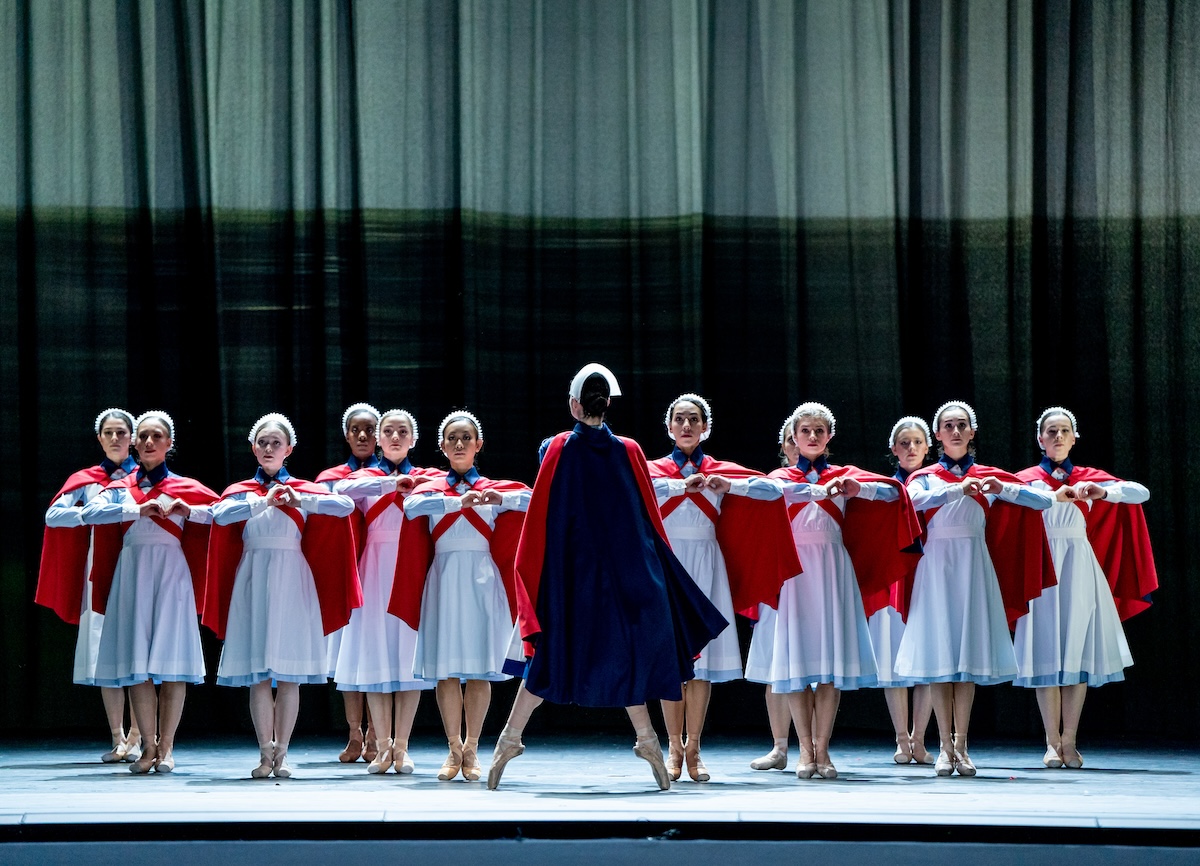
I've often said that a film retelling will destroy a brilliant literary work and a mediocre book can make a great film. My example is Mario Puzo's potboiler, The Godfather, which was made into a classic film series by Francis Ford Coppola. My theory has been turned on its head twice with Atonement, adapted from the 2001 novel by Ian McEwan. The 2007 movie directed by Joe Wright struck the perfect balance of visual embellishment and adherence to the original storyline. The beauty, sensuality, and tragedy of doomed lovers comes to life again with the Joffrey Ballet's production, choreographed and directed by Cathy Marston.

Marston has choreographed other literary masterpieces for Joffrey including Steinbeck's Of Mice and Men and Bronte's Jane Eyre. Like those productions, Atonement has a naturalism and grace amplified by the perfection and precision of the Joffrey Ballet Ensemble. The story begins in 1935 at the English countryside estate of the Tallis family. Cecilia Tallis (Amanda Assucena) has grown up with Robbie (Alberto Velazquez), the housekeeper's son who was part of the family. Her precocious younger sister Briony (Yumi Kanazawa as the younger Briony and Lucia Connelly as the adult) follows Celia and Robbie around the estate as both a beloved child and a pest.
Briony witnesses her cousin Lola being assaulted by someone in the woods. She later sees her sister and Robbie making love and does not know the difference between the violence of assault and passion during sex. The choreography for both incidents has similarities in movement and positioning. Adding to the tension is Laura Rossi's score. It is percussion forward with counterpoint passages and atonality making a perfect soundtrack for a tale of passion and war. Briony accuses Robbie of rape and of writing a sexually explicit letter to Cecilia. (He did write it but didn't intend to send it and it got to Briony by mistake.)

Laura Rossi's score elevates the drama and tension of Atonement. It is percussion forward with counterpoint passages and atonality creating a perfect soundtrack for a tale of passion and war. Lyric Opera Orchestra accompanied the ballet beautifully under the direction of Maestro Scott Speck. The orchestra brings Rossi's score to life. The skilled musicians imbue the modernist score with atmospheric nuance.
Briony's accusation sets off a chain of events with Robbie going to prison and then being conscripted. A brokenhearted Cecilia joins the war effort as a nurse and Briony throws herself into dance training. In McEwan's book, Briony is a novelist who wants to write a different story to atone for ruining two lives with her accusation. Michael Levine's stage design is linear and set in squares or rectangles to illustrate the rigidity of training for war, nursing, and dance. A dance barre descends from the rafters in front of soldiers on the battlefield. It is powerful imagery complementing the choreography as a visual counterpoint.

Atonement is set during World War II and contains brilliant group dancing for military maneuvers and training. Bregje Van Balen's costume design palette is dark green for the soldiers with red and white for the war nurses. The scenes of training are syncopated dancing like a song done in rounds. It was hypnotic watching the soldiers seemingly flying through the air and turning in formation. There was a Joffrey signature take on rhythmic gymnastics with the nurse regiment waving white cloth—perhaps symbolic of folding bandages.

The Joffrey Ballet uniquely provides visual accompaniment that always complements the dancers. Martin Gebhart's lighting design sculpts the sinuous movements of Robbie and Cecilia and emulates the flickering searchlights and flares on the battlefield. The backdrop of the Tallis estate is reminiscent of the work of the landscape painter Théodore Rousseau. Again, Michael Levine's color choices are evocative and almost tactile. The violence of rape against the velvety greens and brown tones adds a shock value that elevates the story.
Of course, the Joffrey dancers are beyond mere interpretive dance. Assucena and Velazquez give Cecilia and Robbie fire, wonderful emoting, and simmering chemistry. Kanazawa as young Briony projects innocence and curiosity. Her posture and facial expressions have a childlike quality that is endearing and frightening. A sheltered child such as Briony cannot interpret adult emotions. Violence and passion are indiscernible, leading to devastating loss.

Lucia Connelly as the adult Briony is a portrait of regret and unassuaged grief. Connelly's portrayal of Briony is palpable. She beats herself and prostrates herself before Cecilia and Robbie to no avail. Her means of atoning for her accusations is to choreograph stories that create hope, passion, and beauty. It is a masterful performance.
My only critique is with the way the epilogue is presented. I wish the curtain had not dropped to delineate between Briony's creation and the reason for her magnum opus. I understood it but it broke the rhythm of the performance as a whole. There is a drag between the climax and the epilogue. I felt emotionally invested in the dancing and the characters but the adrenaline rush of what I had experienced crashed and a new immersion in Briony's story was required. The epilogue is done beautifully as a portrayal of heartbreak and tragedy. It brings the horror of World War II in England vividly to life. Cathy Marston has created a masterwork that interprets a complex literary work. I highly recommend that you see Atonement.
Atonement runs through October 27 at the Lyric Opera House, 20 N Wacker Drive. For more information and tickets, please visit www.joffrey.org.
For more information on this and other productions, see theatreinchicago.com.
Support arts and culture journalism today. This work doesn't happen without your support. Contribute today and ensure we can continue to share the latest reviews, essays, and previews of the most anticipated arts and culture events across the city.
